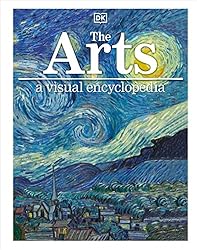Art is a powerful teaching tool for bringing history to life. Learning history through art brings the past to life and empathy.

Some links on this site are affiliate links and I may earn a small commission at no cost to you. Thank you! Learn more.
Tips for Teaching History Using Art
What You'll Find on This Page
I love to use art to bring history to life! Here are a few tips for using art to bring history to life:
- Show children paintings and sculptures from the time period. Talk about how the art reflects popular figures and values of the time.
- Examine sculptures and paintings depicting a historical event from different artists and time periods. How are the depictions the same? How are they different?
- Ask children to create their own artistic depictions of a historical event.

If you are looking for a good book to start with, The Arts: A Visual Encyclopedia covers art work dating all the way back to prehistoric caves through 21st century contemporary street art.
Learning History Through Art: Rodin’s Burghers of Calais
Do you know the story of the Burghers of Calais? In 1347, England had placed the French Port of Calais under siege.
The siege lasted for over a year, and the residents were starving.
King Edward of England offered to spare their lives if six of their leaders would surrender to him.
Eustache de Saint Pierre, one of the wealthiest leaders in the town, was the first to surrender, and five other men volunteered to join him, leaving the town for likely death.
King Edward ordered them to leave the town with nooses around their necks, carrying the keys to the city and the castle.
Edward’s wife, Philippa of Hainault, convinced her husband to spare their lives for the sake of their unborn child.
I love this story, both because of the sacrifice of the six burghers and the queen’s merciful intercession for their sake.
We visited Stanford campus, and the kids were able to see Rodin’s sculptures of the six burghers who offered up their lives.
Rodin was actually criticized for these sculptures, because critics felt that they were not heroic enough. Rodin’s statudes show pain and anguish, emotions not typically connected to heroism.
These powerful human emotions are actually my favorite part of the sculptures. The above photo of Emma shows that Rodin’s sculpting taught her about the sacrifice found within this story in a way that no heroic statue could.
What are your favorite ways to teach history? Have you used art before? What are your favorite ways to use art to bring history to life?
Share comments and feedback below, on my Facebook page, or by tagging me on Instagram. Sign up for my newsletter to receive book recommendations, crafts, activities, and parenting tips in your inbox every week.
MaryAnne is a craft loving educator, musician, photographer, and writer who lives in Silicon Valley with her husband Mike and their four children.


Great post! I took art history in college, it was intense and that is what it was, world history told though art! I think I would enjoy it so much more today then I did back then :-)
Wonderful post!
I had vaguely heard of the burghers but never knew about their sacrifice. Great to learn! Love the connection of art to history!
I’ve got a BA in art history so your experience with Rodin’s sculptures totally makes me smile. I love that you’re exposing your kids to art and using it as a way for them to connect with the past!
Hooray! I wish I had taken some art history classes in college, but at least it’s a subject I can learn about now!
I didn’t know that we have Rodin sculptures here. Many-many copies of them exist, including one in Met in NY and also one I’ve seen in Rodin’s museum in Paris. Very cool experience!
Stanford has a LOT of them! You’ll have to come see them sometime :)
That photo of Emma melts my heart. How wonderful that you told her the story so she could empathise with the pain of those men who left their homes.
There is a little sculpture garden of Rodin’s work in Paris that I love love love. I think of that garden rather than the Eiffel Tower when I think back on my Paris trips!
I love that photo of Emma. If you are ever in the California Bay Area, you should definitely check out Stanford’s Rodin sculpture garden. It is amazing!
I totally agree, art and history together, they make a great pair.
Oh my gosh I love that picture! Fabulous!
We love art museums. We are always wowed!
Art museums are amazing places to visit – and many of them are free or inexpensive to visit!
Rodin is magic! I love that artwork. So powerful. I wonder how many he made, because we have one at one of the museums here in Dallas as well.
French law states that only 12 casts can be made from any of Rodin’s works. The one we visiting (on Stanford University campus) has the figures as individual casts; most museums has them cast as one single piece (the same figures, but a single base). Is that the version you have in your museum in Dallas?
That’s so cool, MaryAnne. We take our kids to museums, but I admit, we don’t get nearly that detailed with what the actual art is. Instead, we’re chasing kids around or doing a quick walk through the exhibits. So far we’ve had better luck with hands-on exhibits more than studying works of art. Hopefully once they grow up some more we can do that!
It definitely gets easier as kids get older, but my kids still prefer art they can touch – like these casts!